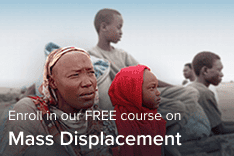Nyakaar abandoned her home in South Sudan when armed conflict threatened her village. She found safety in the Bentiu Protection of Civilians camp, a U.N.-run camp for internally displaced South Sudanese people where World Relief operates health and nutrition programs. Shortly after arriving, Nyakaar gave birth to her son, Bone.
By mid 2024, the U.N. estimated a record-breaking 122.6 million people had been forced to flee their homes. That’s more than 1 in every 66 people globally.
While many of us think of refugees who have fled across borders when we hear the words “mass displacement,” the majority of displaced people worldwide are actually internally displaced within their home country, people like Bone and his mother.
The causes of mass displacement are many, and the repercussions reach far and wide — for those forced to flee, often with little more than the clothes on their back, and the communities they seek safety in. Today, we’re taking a bird’s eye view of mass displacement to help you understand what causes people to leave their homes, who are fleeing and how people across the globe are joining World Relief to address the drivers of mass displacement and care for those who are displaced.
*These numbers reflect the latest estimates from the U.N. High Commissioner for Refugees. This blog was originally written on May 10, 2022 and updated on February 24, 2025.
We’re making a difference in the lives of real people impacted by displacement. Read their stories in our 2024 Annual Report.
What causes mass displacement?
People are displaced from their homes for myriad reasons — persecution, conflict, violence, human rights violations and climate-related factors to name a few.
The conflict in the Middle East is the most recent example of how war can force millions of people to flee their homes. However, there are many other conflicts and crises which are driving people from their homes, communities and countries.
For example, violence in the Darfur region of Sudan has caused many to flee in search of a safer place to live, farm and raise their children. Some of these families remain internally displaced while others have fled across international borders into Chad and other surrounding countries.
Overall, 65% of the world’s refugees are from just four countries: Syria, Venezuela, Ukraine and Afghanistan. Though crises like these have received varying levels of media attention, the needs of the displaced remain critical.
Refugees, Asylum Seekers and IDPs
Many times, displaced people flee to regions or countries surrounding their home region, while a smaller percentage relocate to a more distant country. A displaced person can fall under several categories:
- Internally Displaced People
- Refugees
- Asylum Seekers
Internally displaced people (IDPs) make up the largest category. These are people who have been displaced within their own country. They have been forced to flee their home and region, and have resettled in a different part of the same country in which they already lived. Currently, 68.3 million people are classed as IDPs.
Refugees make up the next largest group of displaced people. These are people who have been given legal residency status in a country other than their home country. It’s likely that you’ve read stories of refugees like Bohdan, Malian and Souzan — people who left their home countries due to conflict or persecution, applied for refugee status and were resettled right here in the United States.
Today, there are about 37.9 million people with refugee status in the world.
In 2024, the U.S. maintained the refugee admissions cap at 125,000, with additional pathways for Ukrainaians, Haitians, Venezuelans and other displaced populations through humanitarian parole programs. Less than 1% of the world’s refugees are currently given the opportunity to permanently resettle in places like the U.S., Canada and Europe. Since the Trump Administration has taken office, U.S. resettlement of refugees has been suspended altogether, pending a 90 review period.
Asylum seekers make up the third and smallest category of displaced people. These are people who have fled to another country, but who have not yet been granted official refugee status. These women, men and children may have to wait years to receive an official status.
Currently, there are about 5.4 million asylum seekers living around the world today.
While some forcibly displaced people will one day be able to return home, for many, the drivers of displacement can last for generations, making returning impossible.
Host Communities
Another group significantly impacted by displacement is the host community.
The swift influx of refugees into host communities severely impacts those who already live in the region. Often host community members need the same support that refugees, asylum seekers and internally displaced people typically receive.
A large number of IDPs or refugees can mean reduced access to land and water and can cause a scarcity in resources. For example, in Sudan, conflicts have broken out over land usage, as host communities and displaced people seek to utilize the scarce land and water resources available in the same area.
World Relief works within these communities to increase access to clean water as well as facilitate peace committees to solve interpersonal conflicts before they grow.
What else is World Relief doing to help?
For over 80 years, World Relief has been at the forefront of serving refugees and internally displaced people across the globe. Today, we boldly continue that legacy in partnership with the global church. Here are just some of the ways we’re serving displaced people around the world:
- In Ukraine, more than 10 million people remain displaced. We have provided shelter, food and psychosocial support, including mental health care training for local church leaders.
- In Sudan, the world’s largest displacement crisis continues, with over 11 million people forced to flee their homes. Despite extreme challenges, we have continued to provide food, clean water, healthcare and protection services to hundreds of thousands in Darfur and eastern Sudan. Our new office in Chad is also supporting Sudanese refugees.
- In the Middle East, millions have been forced from their homes due to escalating conflict. Since October 2023, we have worked with local partners to provide emergency assistance, including medicine, food, clean water and safe sanitation.
- In DR Congo, ongoing conflict has displaced over 6.4 million people, contributing to one of the world’s longest-running humanitarian crises. We remain committed, directly serving communities through agricultural support, community peacebuilding, family strengthening programs and emergency food assistance.
- In Haiti, escalating violence and instability have forced nearly 700,000 people from their homes. While many organizations have left, we have expanded its efforts, leading a coalition of NGOs to assist thousands in need with clean water, cash transfers for essential needs, hygiene supplies and prevention of violence against women and girls.
- At the U.S.-Mexico border, asylum seekers face complex legal challenges and uncertain futures. We are working alongside local churches and community networks in border regions like San Diego-Tijuana to provide temporary shelter, meals and legal services.
- Across the U.S., we help refugees, asylum seekers and other immigrants rebuild their lives through resettlement and support services like housing assistance, legal services, job training, ESL classes, trauma-informed mental health support and family reunification assistance.
- At the local and national level, we speak up for those fleeing violence, persecution and poverty by advocating for just and compassionate policies that protect vulnerable people, uphold human dignity and create opportunities for communities around the world to thrive.
Mass displacement remains one of the largest and most challenging crises of our time — a truth that will take intentional coordination and investment between local and international communities, churches, governments and non-profit organizations to address.
At World Relief, we believe Jesus came to earth to love the vulnerable. Jesus didn’t bring hope and salvation from a distance. Instead, he came to us, showed us love and suffered with us. Whether we are welcoming refugees and asylum seekers into our own communities or providing relief to those displaced overseas, we get to be the hands and feet of Jesus, sharing his love to a world in need.
When you give to World Relief, you help refugee families rebuild their lives in the U.S., enable us to respond quickly to the latest displacement crises and address the root causes of mass displacement like poverty and climate disasters around the world.
Together, we can respond to global crises with holistic, transformative solutions that help families flourish and communities thrive.

Lydia Dawson served as World Relief’s Humanitarian and Disaster Response Unit Program Officer in Sudan, and in disaster response worldwide. Prior to joining World Relief, Lydia worked in homeless services and community development in Oregon and California. She is passionate about equity and honor for underrepresented groups, both locally and internationally.

Jessica Galván is Sr. Content Writer at World Relief. She is passionate about storytelling and amplifying diverse voices to reveal the beauty of God’s creation. She is also the Editorial Director for Chasing Justice and prior to World Relief, she was a freelance writer and editor for a variety of clients in publishing, most recently Penguin Random House. When she isn’t wordsmithing for the pursuit of faith and justice, she is spending time with her husband and their 3 children in the Houston, TX area.

